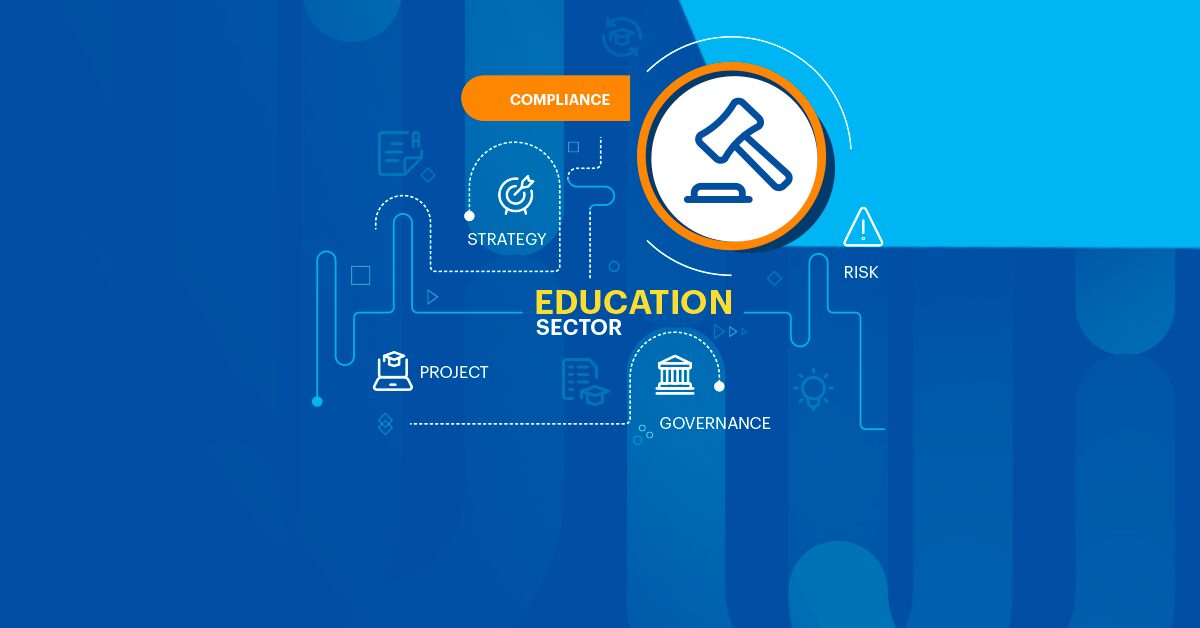The education sector is having to swat up on something that, if left unaccounted for, can expose students and staff to risks and institutions to fines, sanctions, and other penalties: regulatory compliance. To say the sector has become highly regulated is an understatement, with countless standards and laws holding it to account.
Education institutions the world over must comply with everything from health and safety controls and data privacy laws to curriculum guidelines and facility standards. The dynamic nature of this regulatory landscape means they must also keep pace with constant changes to the regulatory compliance terrain – a challenge that has been exacerbated by the Covid-19 pandemic. However, in an age of sweeping educational reforms and budget constraints, these institutions often lack the time and resources needed to meet their regulatory requirements.
A quick worldview
UK
The government’s Department for Education provides statutory guidance for schools and local authorities in the UK. These provisions are comprehensive and include admissions, assessment, curriculum, safeguarding, and staff employment.
The Office for Standards in Education, Children’s Services and Skills (Ofsted) is a non-ministerial department of the UK government, reporting to Parliament. Ofsted is responsible for inspecting services that provide education and skills for learners of all ages, including state schools.
United States
The ‘Every Student Succeeds Act’ (ESSA) was signed by President Obama in 2015. This bipartisan measure is the primary law for K–12 public education in the US and holds schools accountable for how students learn and achieve.
The ESSA gives individual states a central role in determining how schools account for student achievement – including the achievement of disadvantaged students.
Australia
The Australian Education Act 2013 outlines how government and non-government schools receive funding and how to spend the funding appropriately. The act sets out:
- The rights and responsibilities of organisations in terms of receiving Australian Government funding for school education.
- Broad compliance expectations, to ensure funding accountability.
No matter which country an educational institution is based, they must implement stringent processes to ensure they remain compliant or face the consequences.
Manual processes: the challenges
Traditional manual processes are no longer fit for purpose in the quest to stay compliant in the education sector. Institutions that adopt this antiquated and laborious approach to regulatory compliance are hamstrung by disjointed, complex and time-consuming processes – restricting their ability to meet existing requirements and address change.
These flawed processes – such as emails and spreadsheets – present challenges that compound the already complex regulatory environment:
- Lack of an audit trail: Manual processes fail to detail who reviewed what, the action that was decided upon and when it was implemented.
- Lack of accountability: Deprived of an audit trail, there is no accountability for regulatory compliance.
- Restricts a holistic view of regulatory compliance: A reactive, siloed approach to regulatory compliance restricts an organisation’s holistic view, inhibiting planning, budgeting, and process transparency.
- Inaccurate information: The process of manually tracking and controlling all versions of emails and documents causes information to quickly become out of sync and irrelevant.
- Limited reporting: Regulatory intelligence is curtailed by an inability to facilitate vital reporting functions.
- Wasted resources and spending: Manual regulatory monitoring drains valuable resources and exposes hidden costs through the creation of silos and multiple processes.
How the education sector is using software to digitise compliance processes
Ensuring and demonstrating regulatory compliance is a huge undertaking. Proactive education institutions recognise that spreadsheets and emails deprive them of the structure and process needed to keep track of their actions and provide an audit trail for regulators. Consequently, many are turning to software solutions that streamline and digitise their compliance processes.
Let’s explore how mature institutions are managing their regulatory compliance requirements using purpose-built software.
Obligations library
Half the challenge of regulatory compliance is knowing what rules to adhere to. Software underpins the implementation of a comprehensive obligations library – so institutions know what to follow and when to follow it. Empowered by this database of regulatory requirements – which is updated in real-time – they can prioritise tasks by considering the risk of non-compliance, assigning accountability, promoting ownership, tracking progress, and analysing results.
Many organisations in the education sector are already harnessing this software to automate the non-compliance risk management process by linking it to obligations libraries and establishing controls that notify relevant stakeholders of compliance failures and potential exposure.
Automated policy management tools
Automated policy management tools can help institutions keep track of regulatory requirements, monitor progress, and provide proof of compliance to regulators:
- Provides a central location to store all policies and procedures, which can be housed alongside mandatory regulations.
- Stakeholders can access this vital information conveniently, and benefit from a timestamped history of all revisions and changes.
- Facilitates the implementation of a structured policy approval process with automated workflows – supporting accountability.
- Establish employee attestations that show staff have read and understood the policy.
- Run reports and view their status within convenient dashboards.
Regulatory change management
Software with integrated regulatory feeds from third parties enables education institutions to scan the regulatory horizon and receive notifications when regulations change – providing them with clarity when navigating the dynamic regulatory landscape. Workflows are automatically initiated so they can make – and document – the required changes to remain compliant quickly and efficiently.
This ability to access a broad spectrum of up-to-date regulatory content and intelligence ensures they keep pace with changing rules and regulations. Once embedded, the software can support the creation of a comprehensive regulatory change program with automated workflows and stringent signoff and approval processes.
Audits and inspections
Audits and inspections are commonplace in the education sector to ensure guidelines are being followed, pupils are safe, and the curriculum is on track. Software streamlines the audit trail by aggregating risk and compliance data into a consistent format and storing it centrally with a record of who entered the data and when. In addition, the automated workflows ensure a fully tracked, step-by-step change process, ensuring the relevant signoffs. Automating this process enables institutions to maintain a central audit register that enhances data accuracy, accessibility, and usability.
Maintaining a digital record of regulatory requirements and the action taken engenders an effective process for demonstrating compliance – and progress tracking – to both external auditors and regulators.
Incident management
The ripple effect of unplanned incidents in schools, colleges and universities can have a damaging impact on students, staff, and parents. Take sudden school closures amid Covid lockdowns, for example, which suddenly forced parents to home school their children. A comprehensive incident management process is essential to keep operations running smoothly during an unplanned incident – from ensuring there’s enough staff to maintaining power.
Automated incident management ensures all associated events are managed to a full resolution, without any breakages along the way. Software provides a flexible workflow that details and documents the triage, remediation, and stakeholder notification process. Incidents can subsequently be linked to risk registers and a fully, time-stamped audit trail can be provided.
How the education sector is benefits from the digital revolution
The education sector is experiencing a digital revolution thanks to the streamlined project management and software automation offers. These innovative tools and techniques – that originated to support highly regulated industries like financial services – are simplifying complex compliance requirements across the education landscape.
As organisations in the sector start to embed best-practice compliance tools into their processes, they are taking advantage of compelling benefits:
- Make linkages between data sets across, risk compliance & incident management.
- Create automated rules that add areas of non-compliance to the risk register.
- Log incidents and automatically link them to compliance obligations.
- Set controls that detect emerging risks or flag non-compliance.
- Comprehensive monitoring in a single point of oversight via real-time dashboards and reports – streamlining reporting and audit trails.
If you would like to learn more about how institutions in the education sector are digitising their compliance processes, request a demo. Discover more about how the Camms platform is supporting organisations in the education sector.





